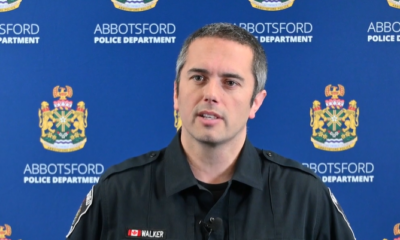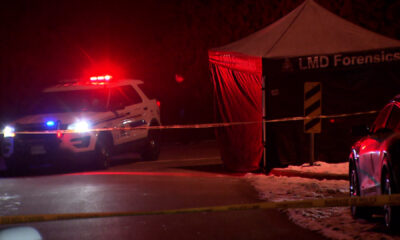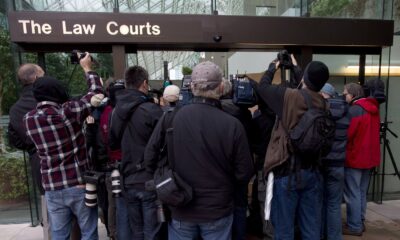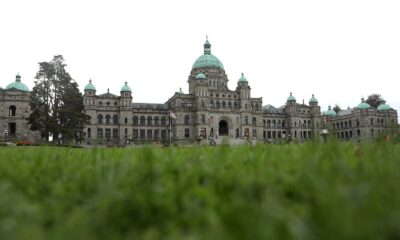Local News
Tsunami watch for much of B.C. coast after massive quake

British Columbia’s emergency preparedness agency says a tsunami is expected to hit parts of Vancouver Island late Tuesday, but with waves of less than 30 centimetres, after one of the world’s strongest earthquakes struck off the southwestern Russian coast.
The massive quake hit with a preliminary magnitude of 8.7, and a tsunami advisory spans much of British Columbia’s coast.
Social media posts from Emergency Info BC said waves measuring less than 30 centimetres were expected to reach Tofino around 11:30 p.m.
It said the waves were expected to first reach remote Langara Island around 10:05 p.m.
The agency says “multiple waves over time” were expected on the B.C. coast, while reports from Russia and Japan say a tsunami has already hit some coastal areas.
Affected B.C. zones include the North Coast and Haida Gwaii, the Central Coast and northeastern Vancouver Island, including Kitimat, Bella Coola and Port Hardy, and the outer west coast of Vancouver Island from Cape Scott to Port Renfrew.
The tsunami advisory also covers the Juan de Fuca Strait from the Jordan River area to Greater Victoria, including the Saanich Peninsula.
The advisory does not include the Strait of Georgia, Gulf Islands, Johnstone Strait or Greater Vancouver.
The U.S. National Tsunami Warning Center had initially issued a lower-level tsunami watch, then upgraded it to an advisory that stretches from B.C.’s north coast south to California’s border with Mexico.
The bulletin from Emergency Info BC said local governments in affected areas are urged to activate their emergency plans and consider evacuating marinas, beaches and other areas near the ocean.
It says strong waves are possible, strong currents are likely, and currents at beaches and in harbours, marinas, bays, and inlets may be especially dangerous.
The advisory posted by Environment Canada, meanwhile, said there is a “possibility of strong localized currents.”
It said no significant inundation was expected, but low-lying coastal areas and beaches may be at risk.
The weather agency said people in coastal areas are advised to stay away from the shoreline and stay alert for any instructions from emergency authorities.
BC Ferries announced that the advisory would not affect ferry operations. It says any change to service will be reported.
B.C. Premier David Eby says the province is “monitoring the situation closely.”
The U.S. National Tsunami Warning Center website shows a tsunami advisory is the second of three warning levels used by the United States and Canada.
The quake struck just before 4:25 p.m. on Tuesday, occurring 136 kilometres southeast of Petropavlovsk in Russia’s Kamchatka region.
If the preliminary magnitude of 8.7 is confirmed, the quake would be among the 10 most powerful recorded since 1900, and the most powerful since the devastating 2011 Tohoku earthquake off Japan, according to a list compiled by the U.S. Geological Survey.
The Associated Press reported that cars jammed streets and highways in Honolulu as the tsunami alerts coincided with the Tuesday afternoon rush-hour. Warning sirens blared as people moved to higher ground. Hawaii schools canceled after-school and evening activities.
A tsunami of 50 centimeters (1.6 feet) was detected at the Ishinomaki port in northern Japan, according to the Japan Meteorological Agency. That was the highest measurement so far among several locations around northern Japan.
The Russian areas nearest the quake’s epicenter on the Kamchatka Peninsula reported damage and evacuations, but no serious injuries.
‘A series of powerful waves’
Dave Snider, tsunami warning coordinator with the U.S. National Tsunami Warning Center in Alaska, said Tuesday evening he had not heard of any specific reports of damage from the tsunami generated by the 8.8-magnitued earthquake.
Forecasted maximum tsunami heights ranged from less than 1 foot to about 5 feet (less than 30 centimeters to 1.5 meters) across parts of Alaska, Oregon, Washington and California, with higher levels projected in isolated areas.
The center said some places could still be feeling impacts from the tsunami for hours or perhaps more than a day.
“A tsunami is not just one wave,” Snider said. “It’s a series of powerful waves over a long period of time. Tsunamis cross the ocean at hundreds of miles an hour — as fast as a jet airplane — in deep water. But when they get close to the shore, they slow down and start to pile up. And that’s where that inundation problem becomes a little bit more possible there.”
Hawaii and Oregon warn residents of potential damage
The U.S. Pacific Tsunami Warning Center said a tsunami had been generated by the quake that could cause damage along the coastlines of all the Hawaiian islands.
“Urgent action should be taken to protect lives and property,” the warning stated. The first waves were expected around 7 p.m. Tuesday local time.
The Oregon Department of Emergency Management said on Facebook that small tsunami waves were expected along the coast starting around 11:40 p.m. local time, with wave heights between 1 to 2 feet (30 to 60 centimeters). It urged people to stay away from beaches, harbours and marinas and to remain in a safe location away from the coast until the advisory is lifted.
“This is not a major tsunami, but dangerous currents and strong waves may pose a risk to those near the water,” the department said.
Russian regions report quake damage
The quake at 8:25 a.m. Japan time had a preliminary magnitude of 8.0, Japan and U.S. seismologists said. The U.S. Geological Survey later updated its measurement to 8.8 magnitude and the USGS said the quake occurred at a depth of 20.7 kilometers (13 miles).
The quake was centered about 119 kilometers (74 miles) east-southeast from the Russian city of Petropavlovsk-Kamchatsky, which has a population of 180,000, on the Kamchatka Peninsula. Multiple aftershocks as strong as 6.9 magnitude were recorded.
The first tsunami wave hit the coastal area of Severo-Kurilsk, the main settlement on Russia’s Kuril Islands in the Pacific, according to the local governor Valery Limarenko. He said residents were safe and staying on high ground until the threat of a repeat wave was gone.
The quake caused damage to buildings and cars swayed in the streets in Petropavlovsk-Kamchatsky, which also had power outages and mobile phone service failures. Russian news agencies quoting the regional Health Ministry saying several people sought medical help in Kamchatka after the earthquake, but no serious injuries were reported.
Among the world’s strongest recorded quakes
The earthquake appeared to be the strongest anywhere in the world since the March 2011 earthquake off northeast Japan that was 9.0 magnitude and caused a massive tsunami that set off meltdowns at a nuclear power plant. Only a few stronger earthquakes have ever been measured around the world.
The tsunami alert disrupted transportation in Japan. Ferries connecting Hokkaido and Aomori on the northern tip of Japan’s Honshu island were suspended, as well as those connecting Tokyo and nearby islands, and some local train operations were suspended or delayed, according to operators. Sendai airport temporarily closed its runway.
Japan’s Fire and Disaster Management Agency said so far no injuries or damages have been reported. The agency, in response to the tsunami alert, issued an evacuation advisory to more than 900,000 residents in 133 municipalities along Japan’s Pacific coast, from Hokkaido to Okinawa. The number of people who actually took shelter was not available.
Japanese nuclear power plants reported no abnormalities. Tokyo Electric Power Company Holdings, which operates the tsunami-hit Fukushima Daiichi nuclear power plant, said about 4,000 workers are taking shelter on higher ground at the plant complex while monitoring remotely to ensure plant safety.
Philippine authorities warned provinces and towns along the archipelago’s eastern coast facing the Pacific of possible tsunami waves of less than 1 meter (3 feet) and advised people to stay away from the beach and coastal areas. “It may not be the largest of waves, but these can continue for hours and expose people swimming in the waters to danger,” Teresito Bacolcol of the Philippine Institute of Volcanology and Seismology told The Associated Press.
New Zealand authorities issued warnings of “strong and unusual currents and unpredictable surges” along coastlines throughout the country. The government emergency management agency said people should move out of the water, off beaches and shore areas, and away from harbors, marinas, rivers and estuaries.
New Zealand is in the South Pacific and about 6,000 miles (9,600 kilometers) from the epicenter.
The quake was the strongest to hit this area in the Kamchatka Peninsula since 1952, according to the local branch of the Geophysical Survey of the Russian Academy of Sciences.
They said that while the situation “was under control” there are risks of aftershocks, which could last for up to a month and warned against visiting certain coastal areas.
Earlier in July, five powerful quakes — the largest with a magnitude of 7.4 — struck in the sea near Kamchatka. The largest quake was at a depth of 20 kilometers and was 144 kilometers (89 miles) east of the city of Petropavlovsk-Kamchatsky.
On Nov. 4, 1952, a magnitude 9.0 quake in Kamchatka caused damage but no reported deaths despite setting off 9.1-meter (30-foot) waves in Hawaii.












